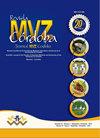Caracterización morfológica y faneróptica de hembras Ovino de Pelo Criollo Colombiano “OPC” Sudán
IF 0.3
4区 农林科学
Q4 AGRICULTURE, DAIRY & ANIMAL SCIENCE
引用次数: 1
Abstract
Etiope Colombian creole woolless sheep (OPC) have been suppliers of animal protein throughout years for peasant and indigenous people. However, the breed status of this animal genetic resource has not been agreed yet, which has favored to accentuate the menace produced by the introduction of foreign breeds since without clarity about the breed classification of Etiope and OPC in general, it is difficult to create awareness among farmers about what they should conserve, improve and why. The objective of this research was to describe morphologically and phaneroptically Etiope OPC, for contributing with its suitable characterization and breed classification. This study was developed in nine farms which were located in the Cordoba and Bolivar Departaments (Colombia), six phaneroptical traits and seven morphological qualitative characteristics were evaluated in 92 ewes. The assessment of these characteristics was made by direct observation with the support of a photographic camera and a digital goniometer. Data analysis was made through the estimation of absolute and relative frequency with the software InfoStat®. Etiopes were generally dark red (43.48%) or very dark red (44.57%) coat color, black-rosy mucosae (93.48%), horizontally oriented ears (100%), sub-convex cephalic profile (72.83%), potbellied (81.52%), inclined rump (86.96%), marbled hooves (81.32%), with occasional wattle presences (24.28%) and pigmented udders (13.19%). In conclusion, this description focused on Etiope sheep, and elaborated minutely, provided elements which help to define the traits which determine the belonging to this ethnic group as well as they help to reach a consensus on the appropriate breed classification of these autochthonous ovines.哥伦比亚“OPC”苏丹克里奥尔毛母羊的形态和扇贝特征
Etiope哥伦比亚克里奥尔毛羊(OPC)多年来一直是农民和土著人民的动物蛋白供应商。然而,这种动物遗传资源的品种状况尚未达成一致,这有利于加剧引进外国品种所产生的威胁,因为如果不明确Etiope和OPC的品种分类,很难让农民意识到他们应该保护、改进什么以及为什么要保护、改进。本研究的目的是从形态学和显象学的角度描述OPC,为其合适的特性和品种分类做出贡献。这项研究在位于科尔多瓦和玻利瓦尔省(哥伦比亚)的九个农场进行,对92只母羊的6个显象光学性状和7个形态定性特征进行了评估。这些特性的评估是在摄影相机和数字测角仪的支持下通过直接观察进行的。数据分析是通过使用InfoStat®软件估计绝对频率和相对频率进行的。表位通常为暗红色(43.48%)或非常暗红色(44.57%),毛色为黑玫瑰色(93.48%),耳朵水平定向(100%),头部轮廓为亚凸(72.83%),大腹便便(81.52%),臀部倾斜(86.96%),蹄有大理石花纹(81.32%),偶尔出现垂肉(24.28%),乳房有色素(13.19%)。总之,本描述集中在表位羊身上,并详细阐述,提供了有助于定义决定该族群归属的特征的要素,以及有助于就这些本地绵羊的适当品种分类达成共识的要素。
本文章由计算机程序翻译,如有差异,请以英文原文为准。
求助全文
约1分钟内获得全文
求助全文
来源期刊

Revista Mvz Cordoba
农林科学-奶制品与动物科学
CiteScore
0.70
自引率
0.00%
发文量
41
审稿时长
6-12 weeks
期刊介绍:
The Journal MVZ Córdoba is an open access international scientific journal financed and edited by the University of Córdoba (Colombia). The journal publishes quarterly, continuously in PDF, XML, Epub, original articles, literature reviews, brief communications and clinical cases, peer-reviewed (double-blind) in Spanish and English, which are related to the agricultural and veterinary sciences. The journal is directed to natural and legal persons of veterinary medicine, animal husbandry, public health, epidemiology, aquaculture, biology, basic biomedical sciences and biotechnology and constitutes a space for academic and scientific discussion around the work of professionals in Veterinary Medicine and Zootechnics. Four-monthly publication.
"The Journal MVZ Córdoba supports the policies for registration of clinical trials of the World Health Organization (WHO) and the International Committee of Medical Journal Editors (ICMJE), since it recognizes the importance of these initiatives for international registration and dissemination. of information about clinical studies, in open access. As a result, since 2007, the journal MVZ Córdoba only publishes clinical research articles that have received an identification number in one of the Clinical Trial Registries validated by the criteria established by WHO and ICMJE, whose addresses are available in the ICMJE website. The identification number is recorded at the end of the summary. "
 求助内容:
求助内容: 应助结果提醒方式:
应助结果提醒方式:


